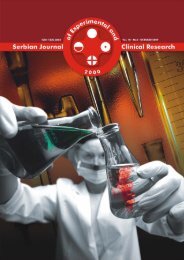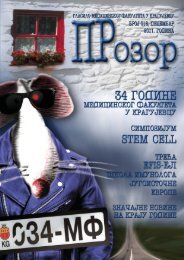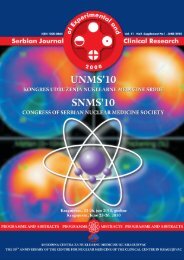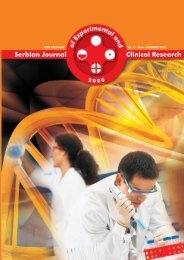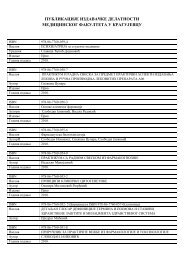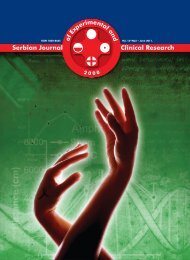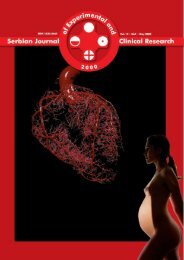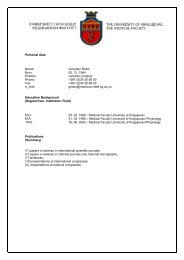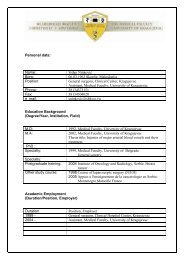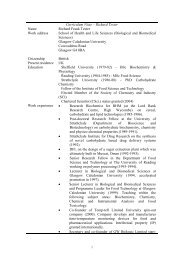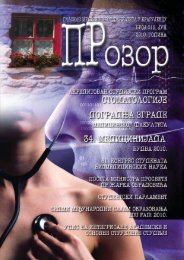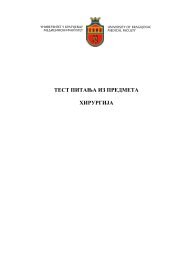neurotoxicity and mechanisms of induced hyperexcitability
neurotoxicity and mechanisms of induced hyperexcitability
neurotoxicity and mechanisms of induced hyperexcitability
You also want an ePaper? Increase the reach of your titles
YUMPU automatically turns print PDFs into web optimized ePapers that Google loves.
with the other rats. After a saline injection, the locomotoractivity levels were very low, <strong>and</strong> there was no significantdifference between the lesioned group <strong>and</strong> thesham-operated group (Figure 2).The effects <strong>of</strong> the microinjection <strong>of</strong> 5,7-DHT on thestartle response, habituation <strong>and</strong> prepulse inhibitionThe startle amplitude in the pulse-alone trials <strong>and</strong> thehabituation <strong>of</strong> the rats were not different between the mP-FC-lesioned rats compared to the sham-operated controls(Figure 3). An ANOVA revealed that there was no significantmain effect <strong>of</strong> group or <strong>of</strong> the habituation x group interaction.Figure 4 appeared to suggest that the mPFC-lesionedrats showed an increase in prepulse inhibition at PP2 <strong>and</strong>PP4 compared to the sham-operated controls; however, anANOVA indicated that there was no significant main effect<strong>of</strong> group or <strong>of</strong> the prepulse x group interaction.DISCUSSIONThe behavioural assessment <strong>of</strong> rats with serotonergiclesions <strong>of</strong> the mPFC, using the locomotor hyperactivity <strong>and</strong>prepulse inhibition paradigms, revealed that there were nodifferences between the lesioned <strong>and</strong> control groups. Thepresent findings suggest that normal regulation <strong>of</strong> locomotoractivity <strong>and</strong> prepulse inhibition is independent <strong>of</strong> serotoninrelease from terminals in the mPFC.Figure 3Effect <strong>of</strong> sham surgery (n=10) or 5,7-DHT lesions <strong>of</strong> the mPFC (n=9) onstartle amplitude, startle habituation <strong>and</strong> prepulse inhibition. The top panelillustrates the basal startle reactivity <strong>and</strong> the startle habituation. The dataare expressed as mean startle amplitudes ± SEM for each <strong>of</strong> the four blocks<strong>of</strong> ten 115 dB pulses. The bottom panel illustrates the prepulse inhibition <strong>of</strong>the acoustic startle response. The prepulse inhibition is expressed as the %inhibition ± SEM at different prepulse intensities. There were no significantdifferences between the groups as indicated by ANOVA.The effects <strong>of</strong> the microinjection <strong>of</strong> 5,7-DHT onamphetamine- <strong>and</strong> phencyclidine-<strong>induced</strong> locomotorhyperactivityThe locomotor hyperactivity caused by treatmentwith amphetamine or phencyclidine was not significantlydifferent between sham-operated rats <strong>and</strong> mP-FC-lesioned rats (Figure 2). After treatment with eitheramphetamine or phencyclidine, there was an expectedmain effect <strong>of</strong> time (F 2,34=10.4, p



